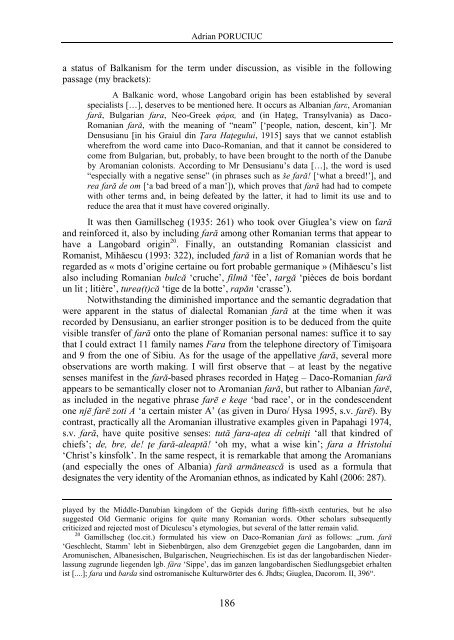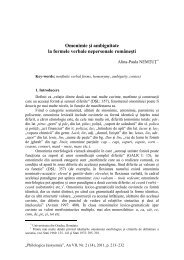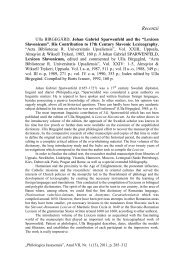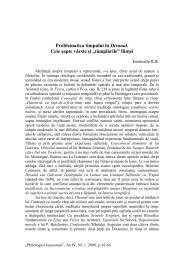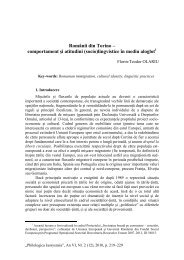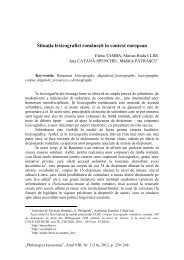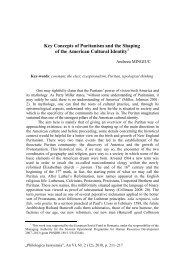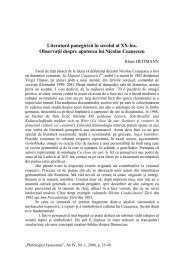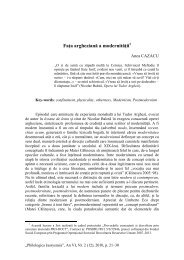O sutÄ de ani de cartografie lingvisticÄ româneascÄ - Philologica ...
O sutÄ de ani de cartografie lingvisticÄ româneascÄ - Philologica ...
O sutÄ de ani de cartografie lingvisticÄ româneascÄ - Philologica ...
Create successful ePaper yourself
Turn your PDF publications into a flip-book with our unique Google optimized e-Paper software.
Adrian PORUCIUC<br />
a status of Balk<strong>ani</strong>sm for the term un<strong>de</strong>r discussion, as visible in the following<br />
passage (my brackets):<br />
A Balk<strong>ani</strong>c word, whose Langobard origin has been established by several<br />
specialists […], <strong>de</strong>serves to be mentioned here. It occurs as Alb<strong>ani</strong>an farε, Arom<strong>ani</strong>an<br />
fară, Bulgarian fara, Neo-Greek φάρα, and (in Haţeg, Transylv<strong>ani</strong>a) as Daco-<br />
Rom<strong>ani</strong>an fară, with the me<strong>ani</strong>ng of “neam” [‘people, nation, <strong>de</strong>scent, kin’]. Mr<br />
Densusianu [in his Graiul din Ţara Haţegului, 1915] says that we cannot establish<br />
wherefrom the word came into Daco-Rom<strong>ani</strong>an, and that it cannot be consi<strong>de</strong>red to<br />
come from Bulgarian, but, probably, to have been brought to the north of the Danube<br />
by Arom<strong>ani</strong>an colonists. According to Mr Densusianu’s data […], the word is used<br />
“especially with a negative sense” (in phrases such as še fară! [‘what a breed!’], and<br />
rea fară <strong>de</strong> om [‘a bad breed of a man’]), which proves that fară had had to compete<br />
with other terms and, in being <strong>de</strong>feated by the latter, it had to limit its use and to<br />
reduce the area that it must have covered originally.<br />
It was then Gamillscheg (1935: 261) who took over Giuglea’s view on fară<br />
and reinforced it, also by including fară among other Rom<strong>ani</strong>an terms that appear to<br />
have a Langobard origin 20 . Finally, an outstanding Rom<strong>ani</strong>an classicist and<br />
Rom<strong>ani</strong>st, Mihăescu (1993: 322), inclu<strong>de</strong>d fară in a list of Rom<strong>ani</strong>an words that he<br />
regar<strong>de</strong>d as « mots d’origine certaine ou fort probable germ<strong>ani</strong>que » (Mihăescu’s list<br />
also including Rom<strong>ani</strong>an bulcă ‘cruche’, filmă ‘fée’, targă ‘pièces <strong>de</strong> bois bordant<br />
un lit ; litière’, turea(t)că ‘tige <strong>de</strong> la botte’, rapăn ‘crasse’).<br />
Notwithstanding the diminished importance and the semantic <strong>de</strong>gradation that<br />
were apparent in the status of dialectal Rom<strong>ani</strong>an fară at the time when it was<br />
recor<strong>de</strong>d by Densusianu, an earlier stronger position is to be <strong>de</strong>duced from the quite<br />
visible transfer of fară onto the plane of Rom<strong>ani</strong>an personal names: suffice it to say<br />
that I could extract 11 family names Fara from the telephone directory of Timişoara<br />
and 9 from the one of Sibiu. As for the usage of the appellative fară, several more<br />
observations are worth making. I will first observe that – at least by the negative<br />
senses m<strong>ani</strong>fest in the fară-based phrases recor<strong>de</strong>d in Haţeg – Daco-Rom<strong>ani</strong>an fară<br />
appears to be semantically closer not to Arom<strong>ani</strong>an fară, but rather to Alb<strong>ani</strong>an farë,<br />
as inclu<strong>de</strong>d in the negative phrase farë e keqe ‘bad race’, or in the con<strong>de</strong>scen<strong>de</strong>nt<br />
one një farë zoti A ‘a certain mister A’ (as given in Duro/ Hysa 1995, s.v. farë). By<br />
contrast, practically all the Arom<strong>ani</strong>an illustrative examples given in Papahagi 1974,<br />
s.v. fară, have quite positive senses: tută fara-aţea di celniţi ‘all that kindred of<br />
chiefs’; <strong>de</strong>, bre, <strong>de</strong>! ţe fară-aleaptă! ‘oh my, what a wise kin’; fara a Hristolui<br />
‘Christ’s kinsfolk’. In the same respect, it is remarkable that among the Arom<strong>ani</strong>ans<br />
(and especially the ones of Alb<strong>ani</strong>a) fară armănească is used as a formula that<br />
<strong>de</strong>signates the very i<strong>de</strong>ntity of the Arom<strong>ani</strong>an ethnos, as indicated by Kahl (2006: 287).<br />
played by the Middle-Danubian kingdom of the Gepids during fifth-sixth centuries, but he also<br />
suggested Old Germ<strong>ani</strong>c origins for quite many Rom<strong>ani</strong>an words. Other scholars subsequently<br />
criticized and rejected most of Diculescu’s etymologies, but several of the latter remain valid.<br />
20 Gamillscheg (loc.cit.) formulated his view on Daco-Rom<strong>ani</strong>an fară as follows: „rum. fară<br />
‘Geschlecht, Stamm’ lebt in Siebenbürgen, also <strong>de</strong>m Grenzgebiet gegen die Langobar<strong>de</strong>n, dann im<br />
Aromunischen, Albanesischen, Bulgarischen, Neugriechischen. Es ist das <strong>de</strong>r langobardischen Nie<strong>de</strong>rlassung<br />
zugrun<strong>de</strong> liegen<strong>de</strong>n lgb. fâra ‘Sippe’, das im ganzen langobardischen Siedlungsgebiet erhalten<br />
ist [....]; fara und barda sind ostrom<strong>ani</strong>sche Kulturwörter <strong>de</strong>s 6. Jhdts; Giuglea, Dacorom. II, 396“.<br />
186


